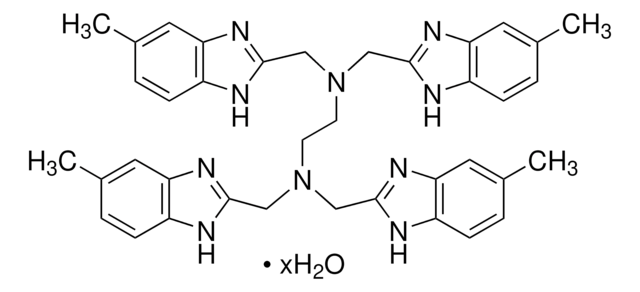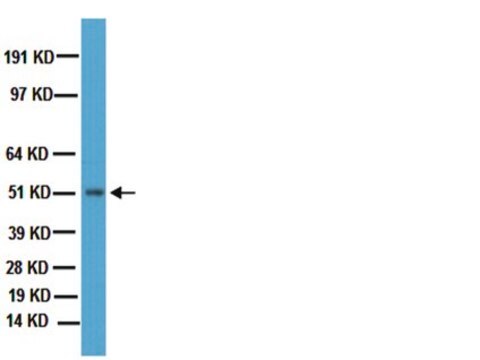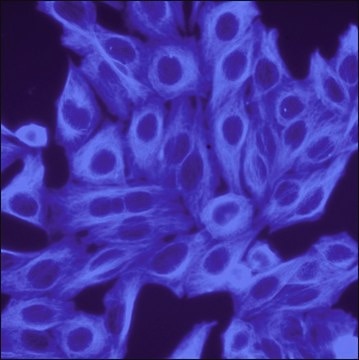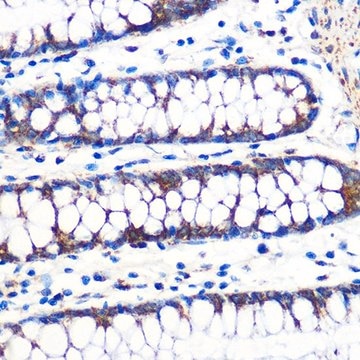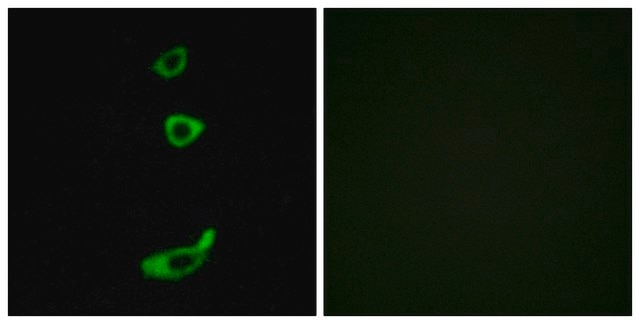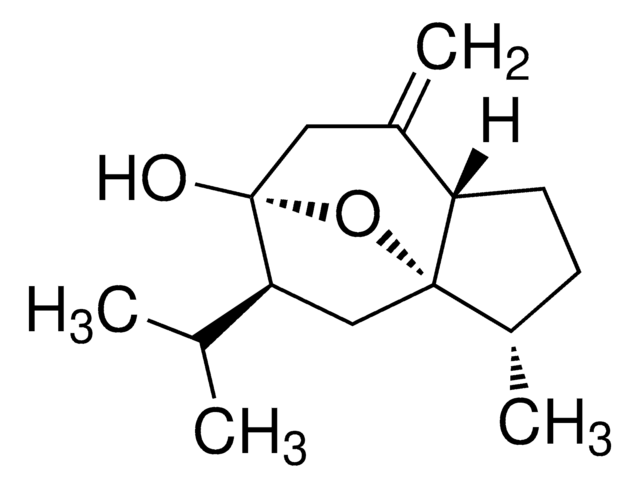CBL188
Anti-Clathrin Antibody, clone CHC5.9
clone CHC5.9, Chemicon®, from mouse
Sign Into View Organizational & Contract Pricing
All Photos(1)
About This Item
UNSPSC Code:
12352203
eCl@ss:
32160702
NACRES:
NA.41
Recommended Products
biological source
mouse
Quality Level
antibody form
purified antibody
antibody product type
primary antibodies
clone
CHC5.9, monoclonal
species reactivity
bovine, amphibian, rat, pig, human
manufacturer/tradename
Chemicon®
technique(s)
immunohistochemistry: suitable
western blot: suitable
isotype
IgM
NCBI accession no.
UniProt accession no.
shipped in
wet ice
target post-translational modification
unmodified
Gene Information
human ... CLTC(1213)
Specificity
This antibody reacts with the clathrin heavy chain from a diverse range of species. In nervous tissue it cross-reacts with another coated vesicle polypeptide of 190 kDa which is not present in isolated clathrin triskelions. In some epithelial cells of certain species the antibody may cross-react with a cytokeratin component. It detects coated vesicles from different organs and tissues (e.g. brain, ovary, mammary gland). : Recognizes bovine, rat and amphibian
Immunogen
Coated vesicles (clathrin) of bovine brain.
Application
Anti-Clathrin Antibody, clone CHC5.9 is an antibody against Clathrin for use in WB, IH.
Marker for detection of receptor mediated endocytosis
Suitable for frozen sections
Western blotting KNOW SPECIES
Optimal working dilutions must be determined by the end user.
Suitable for frozen sections
Western blotting KNOW SPECIES
Optimal working dilutions must be determined by the end user.
Research Category
Epitope Tags & General Use
Epitope Tags & General Use
Research Sub Category
Organelle & Cell Markers
Organelle & Cell Markers
Physical form
Format: Purified
The antibody was purified by gel filtration and is presented as 100μg of lyophilysed material. Reconstitute with 1ml distilled water. Final buffer composition is PBS, pH 7.4.
Storage and Stability
Maintain at 2-8°C for up to 12 months from date of receipt.
Analysis Note
Control
Positive reactions using HeLa, SV-40 and RVF-SMC cultured cell lines.
Positive reactions using HeLa, SV-40 and RVF-SMC cultured cell lines.
Legal Information
CHEMICON is a registered trademark of Merck KGaA, Darmstadt, Germany
Disclaimer
Unless otherwise stated in our catalog or other company documentation accompanying the product(s), our products are intended for research use only and are not to be used for any other purpose, which includes but is not limited to, unauthorized commercial uses, in vitro diagnostic uses, ex vivo or in vivo therapeutic uses or any type of consumption or application to humans or animals.
Not finding the right product?
Try our Product Selector Tool.
wgk_germany
WGK 3
flash_point_f
Not applicable
flash_point_c
Not applicable
Certificates of Analysis (COA)
Search for Certificates of Analysis (COA) by entering the products Lot/Batch Number. Lot and Batch Numbers can be found on a product’s label following the words ‘Lot’ or ‘Batch’.
Already Own This Product?
Find documentation for the products that you have recently purchased in the Document Library.
Hisako Furukawa et al.
Laboratory investigation; a journal of technical methods and pathology, 84(7), 828-835 (2004-05-04)
Prion protein (PrP) is known to accumulate in some non-neuronal tissues under conditions unrelated to prion diseases. The biochemical and biological nature of such accumulated PrP molecules, however, has not been fully evaluated. In this study, we established experimental myopathy
Molecular links between endocytosis and the actin cytoskeleton.
B Qualmann et al.
The Journal of cell biology, 150(5), F111-F116 (2000-09-07)
J Hirst et al.
Biochimica et biophysica acta, 1404(1-2), 173-193 (1998-08-26)
Clathrin and adaptors are components of clathrin-coated pits and vesicles. The AP-1 adaptor complex is associated with clathrin-coated vesicles budding from the TGN, while the AP-2 adaptor complex is associated with clathrin-coated vesicles budding from the plasma membrane. The clathrin
G Bruder et al.
Experimental cell research, 164(2), 449-462 (1986-06-01)
We have used a monoclonal antibody (CHC5.9) to identify clathrin (Mr 180,000; 'heavy chain') in coated vesicles, triskelion structures prepared in vitro and in high-speed supernatants (HSS) of cell homogenates from a variety of tissues and species (e.g., brain and
Nadezhda V Popova et al.
Journal of neurochemistry, 118(6), 988-998 (2011-07-14)
TPR-containing Rab8b-interacting protein (TRIP8b) is a brain-specific hydrophilic cytosolic protein that contains tetratricopeptide repeats (TPRs). Previous studies revealed interaction of this protein via its TPR-containing domain with Rab8b small GTPase, hyperpolarization-activated cyclic nucleotide-regulated channel (HCN) channels and G protein-coupled receptor
Our team of scientists has experience in all areas of research including Life Science, Material Science, Chemical Synthesis, Chromatography, Analytical and many others.
Contact Technical Service